3G is the third generation of wireless mobile telecommunications technology, representing a major leap forward from the previous 2G networks. Introduced in the early 2000s, 3G brought about significant improvements in mobile communication, enabling faster data transfer rates, better connectivity, and support for new services like mobile internet browsing, video calling, and multimedia messaging. Before 3G, mobile networks were primarily used for voice calls and basic text messaging. With 3G, mobile phones became versatile devices capable of handling much more data, which paved the way for the smartphone revolution.
Meaning
The term "3G" stands for third-generation wireless technology. Each generation of mobile technology is a set of standards that define the technical capabilities and features of mobile networks. 3G is based on standards developed by the International Telecommunication Union (ITU) under the IMT-2000 specifications. The key aspect of 3G is its data transmission capabilities, which can offer speeds of up to 2 Mbps for stationary users and around 384 kbps for mobile users. This was a significant jump compared to the 2G network's maximum data rate of just 64 kbps.
The underlying technologies behind 3G include UMTS (Universal Mobile Telecommunications System), HSPA (High-Speed Packet Access), and CDMA2000. These protocols allowed for improved internet speeds, greater network capacity, and enhanced voice call quality.
Comparison Chart
| Feature | 1G | 2G | 3G | 4G | 5G |
|---|---|---|---|---|---|
| Introduced | 1980s | 1990s | Early 2000s | 2009–2010 | 2019 onwards |
| Technology | Analog voice | Digital voice, SMS | Mobile data, video calls | Mobile broadband, HD video | Ultra-fast broadband, IoT |
| Data Speed | N/A | Up to 64 kbps | Up to 2 Mbps | Up to 1 Gbps | Up to 10 Gbps |
| Network Type | Analog | Digital | Digital | IP-based (LTE) | IP-based (New Radio, NR) |
| Primary Use | Voice calls | Voice, SMS | Data transfer, video calls | Streaming, video calls | Augmented reality, IoT |
| Latency | High | Moderate | Medium | Low | Ultra-low |
| Devices Supported | Simple mobile phones | Feature phones | Smartphones | Smartphones, tablets | IoT devices, autonomous cars |
Areas of Application
3G had a wide range of applications that transformed how people used mobile devices and connected with one another. These applications included:
-
Mobile Internet Browsing: 3G made it possible for users to browse the internet on their mobile phones at much higher speeds compared to 2G. Websites became more accessible, and services like social media platforms gained popularity.
-
Video Calling: 3G networks introduced the ability to make video calls. Though this was initially a niche service due to the higher cost and data consumption, it set the foundation for modern video communication.
-
Multimedia Messaging Service (MMS): With 3G, users could send pictures, audio, and video clips via MMS, greatly enhancing communication options beyond basic text messages.
-
GPS Navigation: With faster data transfer speeds, 3G made real-time navigation services more feasible, allowing users to access GPS-based apps like Google Maps.
-
Mobile Streaming: Streaming services for audio and video became practical with 3G, though limited by the available speeds and data caps at the time. Services like YouTube started gaining traction for mobile users.
-
App Ecosystem Growth: The rise of 3G coincided with the development of smartphone app stores, which relied on faster internet connections to offer more complex, data-heavy applications.
Pros and Cons
Pros of 3G:
-
Faster Data Speeds: 3G was a huge improvement over 2G in terms of data transfer rates, making internet browsing, app downloads, and multimedia messaging much smoother.
-
Enhanced Call Quality: 3G improved the quality of voice calls, offering clearer communication with fewer interruptions and better coverage.
-
Global Coverage: 3G networks were widely adopted around the world, offering global roaming capabilities in many regions.
-
Support for New Services: 3G networks laid the foundation for services like mobile video calls, GPS, and multimedia messaging.
Cons of 3G:
-
High Power Consumption: 3G devices tended to consume more power, which led to reduced battery life in mobile phones compared to their 2G counterparts.
-
Limited Speeds by Modern Standards: Though 3G was a major improvement over 2G, its speeds are now considered slow compared to 4G and 5G networks.
-
Network Congestion: As more users adopted smartphones, 3G networks could become congested, leading to slower speeds and degraded performance.
-
Cost: Early 3G data plans were more expensive, and many users were initially hesitant to fully embrace mobile internet due to concerns about costs.
FAQ
While 3G is no longer cutting-edge, it was a game-changer in its time, transforming mobile phones into internet-capable devices and paving the way for 4G and 5G networks. Its impact can still be felt in how we use mobile devices today, and in regions where 4G or 5G isn't available, 3G continues to provide valuable connectivity options.
















